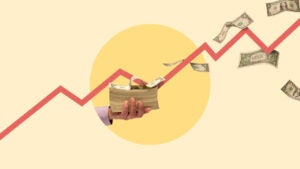Mortgage rate forecast July 2025

Inflation is holding just above the Federal Reserve’s target rate of 2 percent, and the central bank has yet to lower its benchmark rate in 2025. Add up those key variables, and mortgage rates aren’t likely to move much this month.
“A slowing economy should help bring bond yields and mortgage rates a bit lower in July — but just a bit,” says Greg McBride, Bankrate’s chief financial analyst. “Concerns about inflation and escalating government debt will keep a high floor under rates.”
A slowing economy should help bring bond yields and mortgage rates a bit lower in July — but just a bit.— Greg McBride, CFA, chief financial analyst for Bankrate
For months, mortgage rates have been held aloft by the combination of a still-strong economy, inflation fears and growing concerns about a rising federal deficit.
So much for hopes that mortgage rates were headed back into the 5 percent range. The average 30-year mortgage rate began declining from 7 percent last summer, fell to as low as 6.2 percent in September, then quickly reversed course, tracking back above 7 percent by the end of 2024, according to Bankrate’s weekly lender survey. However, as of June 25, rates stood at 6.79 percent.
The Fed doesn’t directly set mortgage prices, but it does influence them. The central bank cut its benchmark rate three times last year. The Fed next meets in late July.
Learn more: How the Fed affects mortgage rates
Will mortgage interest rates go down again?
The possibility of sub-6 percent mortgage has grown fainter. Fannie Mae predicts rates will edge down to 6.5 percent by the end of the year, while the Mortgage Bankers Association expects 30-year rates will barely decrease, to 6.7 percent by the end of 2025.
“Mortgage rates will continue to fall slowly as oil prices fall and inflation data remains muted as tariffs start to take hold,” says Melissa Cohn of William Raveis Mortgage. “Hopes for a Fed rate cut perhaps as soon as next month have also helped bond yields, as several Fed members say that they will support a cut if the inflation picture remains muted.”
Learn more: Housing market trends to watch in 2025
Current mortgage rate trends
Higher mortgage rates have kept homeowners clinging to lower-cost loans, a trend known as the “lock-in effect.” Meanwhile, the median national home price clocked in at $422,800 in May, according to the National Association of Realtors.
Bankrate’s weekly mortgage rate averages differ slightly from the statistics reported by Freddie Mac, the government-sponsored enterprise that buys mortgages and packages them as securities. Bankrate’s rates tend to be higher because they include origination points and other costs, while Freddie Mac removes those figures and reports them separately. However, both Bankrate and Freddie Mac report similar overall trends in mortgage rates.
What to do if you’re getting a mortgage this year
- Improve your credit score. A lower credit score won’t prevent you from getting a loan, but it can make all the difference between getting the lowest possible rate and more costly borrowing terms. The best mortgage rates go to borrowers with the highest credit scores, usually at least 780.
- Save up for a down payment. Putting more money down upfront can help you obtain a lower mortgage rate, and if you have 20 percent, you’ll avoid mortgage insurance, which adds costs to your loan. If you’re a first-time homebuyer and can’t cover a 20 percent down payment, there are loans, grants and programs that can help. The eligibility requirements vary by program, but are often based on factors like your income.
- Understand your debt-to-income ratio. Your debt-to-income (DTI) ratio compares how much money you owe to how much money you make, specifically your total monthly debt payments against your gross monthly income. Not sure how to figure out your DTI ratio? Bankrate has a calculator for that.
FAQ
Why we ask for feedback Your feedback helps us improve our content and services. It takes less than a minute to complete.
Your responses are anonymous and will only be used for improving our website.






